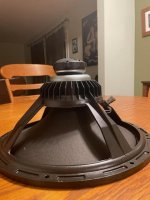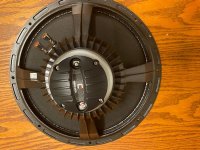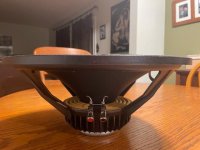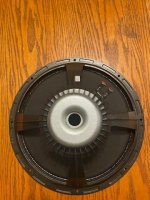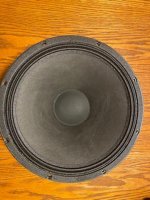The home synergy may not need to be the same as the pro synergy, perhaps I'm the one just speculating. When a horn is used across the loading transition it doesn't cause a problem that I've noticed.
Because the cone will dictate a wider waveguide.
Also, you'll want to cross low enough that the woofer section doesn't get more narrow than that, but you'd normally do that anyway.
Agreed.
So does that mean that there's a sweet spot in terms of how the woofer acts as a waveguide for the tweeter (where a centre horn isn't used for dispersing the high frequencies)?
In example, does the exit angle of a 15" driver (presumably offering a wider dispersion angle) help or hinder the HF, compared to, say, a 10" driver?
Naturally, the different woofer sizes will change the LF characteristics, so maybe there's a trade-off that has to be made somewhere...?
Help me to understand, do you mean a sweet spot in choosing a waveguide angle for the tweeter? In what way are you wanting it to perform best at that angle?
The two woofers do the same thing, just at different frequencies. You can usually estimate where (at a higher frequency) it gets to a certain narrow angle, by looking at the size of the woofer.
The two woofers do the same thing, just at different frequencies. You can usually estimate where (at a higher frequency) it gets to a certain narrow angle, by looking at the size of the woofer.
Help me to understand, do you mean a sweet spot in choosing a waveguide angle for the tweeter? In what way are you wanting it to perform best at that angle?
The two woofers do the same thing, just at different frequencies. You can usually estimate where (at a higher frequency) it gets to a certain narrow angle, by looking at the size of the woofer.
I was thinking in terms of this - if we have a coaxial driver that doesn't add a horn in the centre for the HF, the cone of the LF essentially forms our outer flare of the HF's waveguide. Depending on the size of the driver and depth of the driver I'd imagine this would change.
Does this even matter?
Ok, the cone acts like a horn/waveguide, the angle of that horn does make a difference, yes. It changes in a number of ways so could you be more specific? Were you thinking about things like loading, directivity, diffraction, something else?
There is one thing though, continuing this curve with an outer horn so the result is smooth, makes sense in any case.
There is one thing though, continuing this curve with an outer horn so the result is smooth, makes sense in any case.
Ok, the cone acts like a horn/waveguide, the angle of that horn does make a difference, yes. It changes in a number of ways so could you be more specific? Were you thinking about things like loading, directivity, diffraction, something else?
There is one thing though, continuing this curve with an outer horn so the result is smooth, makes sense in any case.
Thanks Allen, I'm glad I'm starting to make sense! I should have drawn a picture, but for some reason I attempted with words
In terms of your options, I was thinking of loading and directivity...most importantly covering the frequency range 'well', supporting the vocal range (which, given what I've heard with horns, helps with the mid 'boost' due to said loading), and then using directivity as one would in a horn to reduce room reflections interacting with the listener.
A design of that extends outside of the scope of this thread, but given all of the driver options out there I wonder if there's a general consensus on coaxial drivers that would give us a good starting point...for anything really, not just horn loading, but something that's good for your more commonplace sealed or ported enclosures.
Oops. I meant the ribbing on the KL3015cx-8 Eminence, not cx. Confusing drivers.
Thanks Glenn! So I imagine that the curvilinear cone, apart from altering the sound coming from it also affects the dispersion pattern from the compression driver (something that could be modelled in HornResp?) - are any coverage angles mentioned as part of the Vortex kit?
Removing the ribbing probably helps with how the high frequencies travel over the cone...or at least that seems like it would be a preference. I suppose without measurement and comparisons it's all a guess from my inexperienced perspective!
Definitely looking forward to seeing your build, and how they act when they're in use!
Of these, directivity is the most useful goal followed by diffraction because keeping it in line depends on your choices about directivity.In terms of your options, I was thinking of loading and directivity...most importantly covering the frequency range 'well', supporting the vocal range (which, given what I've heard with horns, helps with the mid 'boost' due to said loading), and then using directivity as one would in a horn to reduce room reflections interacting with the listener.
Regarding your midrange 'boost', I've already disagreed with that idea about loading.. and I would not want a boost but if I did I'd use EQ instead.
Directivity and diffraction becomes easier to manage down lower if you choose to go wide, but this depends on your room.
Thanks Glenn! So I imagine that the curvilinear cone, apart from altering the sound coming from it also affects the dispersion pattern from the compression driver (something that could be modelled in HornResp?) - are any coverage angles mentioned as part of the Vortex kit?
Removing the ribbing probably helps with how the high frequencies travel over the cone...or at least that seems like it would be a preference. I suppose without measurement and comparisons it's all a guess from my inexperienced perspective!
Definitely looking forward to seeing your build, and how they act when they're in use!
Vortex Speaker Kits | HiFiCircuit
This will link you to the info you may want, and there are links within it as well as measurement graphs. Glenn.
Of these, directivity is the most useful goal followed by diffraction because keeping it in line depends on your choices about directivity.
Ah, understood. There's always more to learn!
Regarding your midrange 'boost', I've already disagreed with that idea about loading.. and I would not want a boost but if I did I'd use EQ instead.
I'm probably misunderstanding the concept then, certainly with regard to midrange response. Do you find that increasing the midrange through EQ is more easy to control than working with a horn, or is it for something else?
Directivity and diffraction becomes easier to manage down lower if you choose to go wide, but this depends on your room.
Wide's fine. The room I'm working with at the moment is unfinished, and I can put some absorption in if needed
Coaxials: Another DIY Group Project. | Page 72 | AVS Forum
Post #1427 has pics of the motor/ horn assembly.
Post #1427 has pics of the motor/ horn assembly.
Vortex Speaker Kits | HiFiCircuit
This will link you to the info you may want, and there are links within it as well as measurement graphs. Glenn.
Those are measurements we could work with!
What boost are you talking about, is this something you've measured? Is it something that you want?Do you find that increasing the midrange through EQ is more easy to control than working with a horn,
It sounds to me like you're expecting some kind of boost from some horns, but not from others? Then are you expecting to miss out on something by making the wrong choice of horn? If I'm not mistaken, what is this quality?
What boost are you talking about, is this something you've measured? Is it something that you want?
It sounds to me like you're expecting some kind of boost from some horns, but not from others? Then are you expecting to miss out on something by making the wrong choice of horn? If I'm not mistaken, what is this quality?
Sorry, I'm confusing things again! What I said definitely doesn't make any sense...of course we'd use EQ to correct any levels! It's not like we'd go and re-design and rebuild a horn (or any speaker for that matter) just to change a speaker's response (either raw or in-room)!
The only sense I can make of myself on this subject is (and this might be nonsense too), in your opinion, is the situation of having a horn where you can EQ up the midrange better than having one where you have to EQ it down?
Sorry Allen - feel free to ignore this and go back to the coaxial drivers!
Glenn, I might get in touch with Erich regarding the Vortex 15 drivers as you'd suggested. I saw that Joseph Crowe had a video on the Eminence Beta12-CX and the Selenium DT220i, and it was quite pleasant.
I actually have a pair of Yamaha JA6681-B compression drivers, but they're a 1.4" exit 4-bolt mounting system...I don't have the tooling to create a screw-on replacement for the mounting place (they're just a 1" driver inside an enclosure with a conical adapter), so I'll probably have to pass on those (and probably sell them). It's a shame, because they're a very smooth-sounding driver!
In a domestic situation, aside from the simple matter of EQ and all else considered, the main difference between one horn and another is going to boil down to different directivity, as well as the component of diffraction.in your opinion, is the situation of having a horn where you can EQ up the midrange better than having one where you have to EQ it down?
So, a slight difference in horn means a slight EQ adjustment but the directivity will be different and that can have its own effect on sound... You might begin by deciding what you want to try to do with it, how much size you can afford etc.
Una, Michael Chua also has the Osprey 12cx/Selenium design that you can email him for the crossover.
Osprey-12 (Eminence 12CX with Selenium D220Ti) – AmpsLab
I see either of the Vortex kits as a no brainer choice at 1/2 price. You get the cd and coax with the pcb board for US$220, and the crossover parts are 60 bucks-ish if you don't upgrade. I was prepared to spend close to a grand on them, but the supply chain issues forced the wait, and they were put on clearance by the time they were back in stock for sale. Glenn.
Osprey-12 (Eminence 12CX with Selenium D220Ti) – AmpsLab
I see either of the Vortex kits as a no brainer choice at 1/2 price. You get the cd and coax with the pcb board for US$220, and the crossover parts are 60 bucks-ish if you don't upgrade. I was prepared to spend close to a grand on them, but the supply chain issues forced the wait, and they were put on clearance by the time they were back in stock for sale. Glenn.
Una, Michael Chua also has the Osprey 12cx/Selenium design that you can email him for the crossover.
Osprey-12 (Eminence 12CX with Selenium D220Ti) – AmpsLab
I see either of the Vortex kits as a no brainer choice at 1/2 price. You get the cd and coax with the pcb board for US$220, and the crossover parts are 60 bucks-ish if you don't upgrade. I was prepared to spend close to a grand on them, but the supply chain issues forced the wait, and they were put on clearance by the time they were back in stock for sale. Glenn.
Good stuff, thanks! The Vortex kits certainly sound like a no-brainer. Is it worth waiting to see if the Vortex-15 would be re-stocked, or is the 12 just as good?
A study of EMI early speakers will be of interest to you. They seemed to have mastered the co-axial in a oval for studio monitors in the early 60's.
There is not a great deal of info on the internet. A pair came to me and they are not a speaker I will part with easily. Very clean and clear. EMI studios became Abby Road Studios on EMI equipment as a example. Rumored the EMI speaker was the studios monitor. Hope someone will be able to add information.
There is not a great deal of info on the internet. A pair came to me and they are not a speaker I will part with easily. Very clean and clear. EMI studios became Abby Road Studios on EMI equipment as a example. Rumored the EMI speaker was the studios monitor. Hope someone will be able to add information.
- Home
- Loudspeakers
- Multi-Way
- Coaxial Questions
